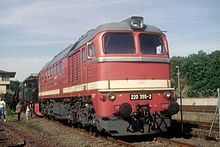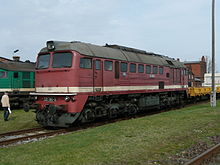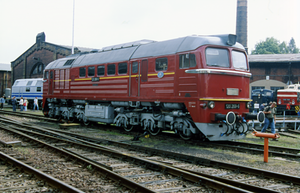DR series V 200
| DR series V 200 DR series 120 DB series 220 |
|
|---|---|
|
DR 120 269 at the Heizhausfest Chemnitz 2009
|
|
| Numbering: | V 200 001–314 from 1970: 120 001–378 from 1992: 220 ... |
| Number: | 378 |
| Manufacturer: | Luhansk locomotive factory |
| Year of construction (s): | 1966-1975 |
| Retirement: | 1995 |
| Axis formula : | Co'Co ' |
| Gauge : | 1435 mm ( standard gauge ) |
| Length over buffers: | 17,550 mm |
| Height: | 4,493 mm |
| Total wheelbase: | 12,800 mm |
| Service mass: | 115.1 t |
| Wheel set mass : | 19.2 t |
| Top speed: | 100 km / h |
| Installed capacity: | 1,471 kW (2000 hp) |
| Traction power: | 1,271 kW |
| Starting tractive effort: | 350 kN |
| Driving wheel diameter: | 1,050 mm |
| Motor type: | 14 D 40 |
| Rated speed: | 750 min −1 |
| Power transmission: | electric |
The V series 200 of the German National Railroad was a series of diesel-electric locomotives . It is the variant of the Soviet type M62 built for the GDR . With the introduction of the EDP numbers at the Deutsche Reichsbahn in 1970, it was renamed the class 120 . The last units were given the all-German series designation series 220 in 1992 .
history
In the 1960s, the conversion of traction from steam to diesel was propagated. For this purpose, locomotives were not only built in Babelsberg and Hennigsdorf , but locomotives from the Luhansk locomotive factory were also imported from the Soviet Union (now Ukraine ). This became necessary because, due to specialization agreements within the Council for Mutual Economic Aid (RGW) in the GDR, no more diesel locomotives of higher performance were to be built in the future. The first of these imported series was the V 200, later the 120 series with 1,470 kW (2,000 hp ) for freight train service. It was the tried and tested type M 62, which had been supplied to Soviet and foreign railways for years. From 1966 to 1975 the Deutsche Reichsbahn purchased a total of 378 locomotives of this series.
technology
The locomotive had a very heavy frame made of double T-beams with top and bottom plates, two three-axle bogies with sliding plates, guided axles and pivot linkages. The primary suspension is implemented using compensating levers, leaf and helical springs .
A 14D40 two-stroke V-diesel engine with two turbochargers and a Roots blower is the heart of this locomotive. The power is 1470 kW at a speed of 750 min −1 . The traction energy was converted by a separately excited direct current generator . The power control was carried out by a magnetic flux regulator in the exciter field of the exciter. The traction motors are direct current series motors . The electric traction power was set to 1270 kW. In order to increase the armature currents of the traction motors in the upper speed range again, the locomotive had two shunt stages , which were switched in parallel to the excitation windings of the six pin- bearing traction motors. The locomotive family of the DR class 130 uses a similar construction .
The fans for the drive motors and the traction generator are mechanically driven by the diesel engine via cardan shafts. The cooling fan was also driven directly by the diesel engine, with a fluid coupling in between for control. The roots blower is a special component. It promotes combustion air and generates a pre-compression of 0.2 bar. This is necessary because a two-stroke engine has to be flushed through; it cannot prime automatically with the inlet slots and outlet valves open at the same time. After the start, the two turbochargers run up and increase the charge air pressure to around 1.2 bar. The diesel engine had an idling speed of 400 min −1 , but its maximum speed was already at 750 min −1 . The engine has cylinders in a V arrangement. The pistons on the B side sit with coupling rods on the main connecting rods on the A side. This changes the piston speeds between the A and B sides. The engine generates different amounts of power on the two cylinder banks . The fuel supply is 3900 liters of diesel oil. A Sifa was available, but Indusi was not.
Since the first 177 locomotives delivered ex works did not have a silencer and thus generated a high level of noise, they were also known colloquially as the "Taiga drum" or "Stalin's last revenge". The silencers for these locomotives were rebuilt by RAW Meiningen and some of them were installed before acceptance.
commitment



The locomotive was intended for heavy freight train service from the start. Since it had no train heating, it was only occasionally harnessed to passenger trains during the summer months. The maximum speed was in favor of traction at 100 km / h.
After all locomotives of the Bundesbahn class 220 had already been taken out of service by the time of reunification , the Deutsche Reichsbahn changed over 200 vehicles from its class 120 to the “class 220” in 1992. Until their final shutdown in 1995, these locomotives carried the class designation 220 in a second assignment even after the merger to form Deutsche Bahn AG .
Whereabouts
Deutsche Bahn AG still owns seven copies for museum purposes. In the traditional Staßfurt depot, the 120 366 from the last series has not been preserved in working order. The Saxon Railway Museum in Chemnitz-Hilbersdorf has the copy 120 269. The Dresden Transport Museum has kept its 120 338 for a long time in its depot at the Dresden-Altstadt Bahnbetriebswerk in the vicinity of the Dresden Railway Museum. The Arnstadt railway depot also owns a model of the 120 series with the 120 274. The 120 198 is received from the Thuringia Railway in Weimar and the 120 001 from the Mecklenburg Railway in the former Schwerin depot .
Some machines were sold to Lithuania and North Korea as well as to German private railways. Some of the locomotives delivered ex works to other countries (former PKP series ST44 from PKP and 781 from ČD ) are also used by German private railways.
As planned, in 2007 the locomotives of the V 200 series were only used by the Leipziger Eisenbahngesellschaft (LEG) in Germany.
V 200 at Werkbahnen
The M62 were also delivered to works railways in the GDR. First of all, the Wismut Werkbahn of SDAG Wismut received five locomotives in 1972 and 1973 for use on its network, which is partly owned by the Deutsche Reichsbahn, between Kayna , Raitzhain and Seelingstädt , which were classified as V 200 501 to 505.
Following this, three machines were delivered to the Geiseltal lignite combine (BKK) for operation in coal traffic in the Halle / Merseburg area, which were given the numbers V 200 506 to 508.
From 1976 to 1978, the Wismutbahn received another ten locomotives, which were numbered as V 200 506 to 515 regardless of the machines previously delivered to the BKK Geiseltal .
In 1993, rail operations at BKK Geiseltal were discontinued, the V 200 506 and V 200 509 (taken over from DR in 1986, former 120 094) were sold to the Wismutbahn. The use of the V 200 at the Wismutbahn ended in 1998.
The V 200 from Wismutbahn and BKK Geiseltal were not included as factory locomotives in the renumbering of the DR.
literature
- Hans Müller, Andreas Stange: The V 200 series - the history of the Taiga drum. EK-Verlag, Freiburg 1997, ISBN 3-88255-201-8
- Hans Wiegard: The Taiga drum. The class V 200 of the Deutsche Reichsbahn. In: LOK MAGAZINE . No. 253 / Volume 41/2002. GeraNova Zeitschriftenverlag GmbH, Munich, ISSN 0458-1822 , pp. 36–53.
- Konrad Koschinski: V 200 of the DR, "Taiga drum". Eisenbahn-Journal, special edition 2/2001, Hermann Merker Verlag, Fürstenfeldbruck

